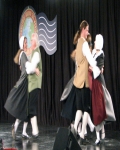
It is a genre of dance wherein selected folk dances from manifold ethnic groups are done by the same dancers, characteristically as part of a regular recreational dance club, for performances or at other events. The dances are normally considered the goods of national or cultural traditions rather than part of an international ethnic. International folk dancers need not be a member of any finicky traditions.
International folk danceis developed in the colonist community of the United States of America during the first half of the 20th century. Ethnic dances such as branles, polkas,quadrilles and others have been done internationally for hundreds of years; yet, the creation of international folk dance as such is often attributed to Vytautas Beliajus,a Lithuanian-American who studied, skilled,and performed dances from various ethnic traditions in the 1930s.
International folk dance has grown into a huge community of dancers, performing grouping and recreational folk dance clubs all through the United States, Europe, Canada, Japan, Australia and other countries. Dance festivals and meetings are held year-round. Dance "camps" or workshops invite teachers to drill dancers in dances from many traditions.These groups typically focus on European dances, but the international folk dance repertoire may comprise dances from each and every part of the world:Europe, Africa, North and South America, the Middle East and few other states.
It is done for a range of purposes, typically for preservation, recreation, or performance. Groups that dance for dissimilar purposes tend to do dances in a different way,and to select different dances. Recreational dancers choose and tend to change/modify the dances according to their own tastes, and as a result of the changes that unavoidably occur as dances are passed on from one person to the next. Performers characteristically choose dramatic, flamboyant, or athletic dances, and they frequently tend to dance with stylized techniques and exaggerated movements. A few recreational international folk dance groups also do dances not strictly considered folk dances. These are dances which are choreographed, or are patrician in nature.Choreographed contemporary Israeli folk dancing is frequently included into international folk dance repertoire.








